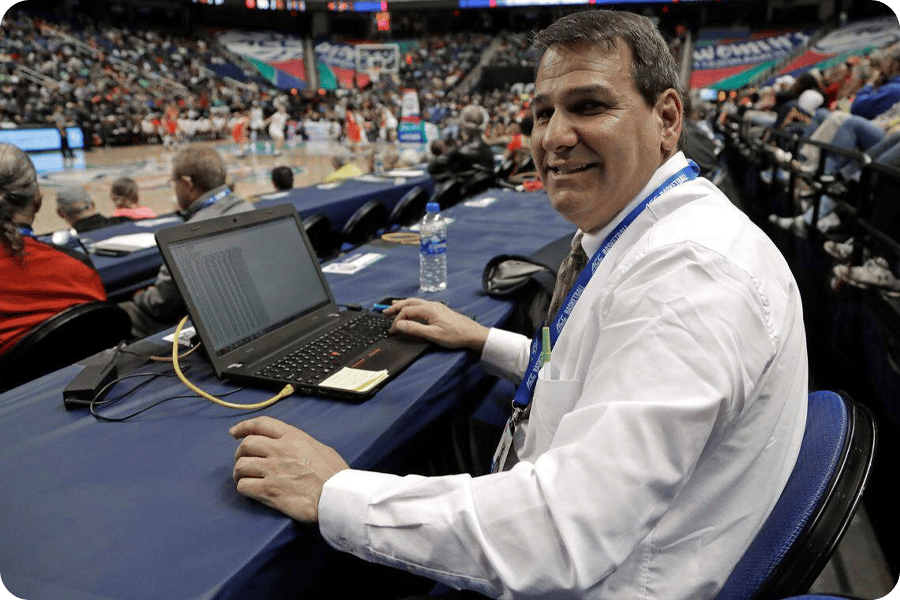- Bottom of the Ninth
- Posts
- ⏲️ How a Fired Ref Solved the NBA's Biggest Problem
⏲️ How a Fired Ref Solved the NBA's Biggest Problem
One moment in 1990 cost Mike Costabile his job. Now his invention runs the NBA.

Happy Wednesday,
Officiating tech is everywhere right now.
ABS is coming to baseball. The NFL is phasing out the chain gang for Hawk-Eye. Soccer has VAR. Tennis has had it for years.
But long before cameras could track spin rate and strike zones in real time, basketball had a different problem: the game clock.
And it was a problem Mike Costabile learned the hard way.
In 1990, Mike was reffing a double-overtime game between the Bucks and Sixers. He blew his whistle. The clock didn’t stop. A few tenths of a second later, the wrong team had won—and Mike’s career in the NBA was ostensibly over.
But instead of walking away, he built something.
That something became the Precision Time System—a referee-operated pack that stops the game clock instantly based on the frequency of their whistle. No latency. No missed calls due to a slow trigger finger at the scorer’s table. Today, it’s used in every NBA game, every major college basketball conference, and every March Madness tournament.
When Jake and I called Mike, we weren’t expecting a business story this wild. But we got one.
Big investors are buying this “unlisted” stock
When the founder who sold his last company to Zillow for $120M starts a new venture, people notice. That’s why the same VCs who backed Uber, Venmo, and eBay also invested in Pacaso.
Disrupting the real estate industry once again, Pacaso’s streamlined platform offers co-ownership of premier properties, revamping the $1.3T vacation home market.
And it works. By handing keys to 2,000+ happy homeowners, Pacaso has already made $110M+ in gross profits in their operating history.
Now, after 41% YoY gross profit growth last year alone, they recently reserved the Nasdaq ticker PCSO.
Paid advertisement for Pacaso’s Regulation A offering. Read the offering circular at invest.pacaso.com. Reserving a ticker symbol is not a guarantee that the company will go public. Listing on the NASDAQ is subject to approvals.
5 Takeaways from the Origins of the Precision Time System

Mike Costabile, founder of the Precision Time System
1. One moment can start a movement.
In 1990, Mike made the technically correct call, but the game clock lagged behind.
“That play should’ve been a foul in the middle of the third quarter, not at the end of the second overtime.”
That moment—and the fallout—pushed him to find a solution to what was essentially a reaction-time problem.
2. The Precision Time System solved a hidden flaw.
Manual timekeeping adds 0.6–0.8 seconds of delay per whistle. Over 60–80 stoppages per game, that’s 30 to 90 seconds of lost play.
Mike’s system removed that variable completely by syncing each ref’s whistle to a belt pack, allowing them to start and stop the clock themselves. “We took the guesswork out of it,” he said.
3. This was a business built out of a garage—literally.
Mike heated his house with kerosene and ate half a Subway sandwich for dinner while developing the system.
“The washer and dryer was the workbench. The kitchen was the shipping room,” he said. “Every day we had nothing, and every day we had to make something.”
4. The NBA didn’t want to hear it—until they couldn’t ignore it.
When Mike first pitched the idea, the league brass told him, “If you thought of it, we’ve thought of it 50 times.” But after a few years—and a lot of hard proof—the NBA made Precision Time mandatory.
“They didn’t want it for free,” Mike told us. “They wanted to pay for it—so they knew I’d still be around.”
5. When tech doesn’t disrupt the experience, it sticks.
Unlike drawn-out video reviews or automated strike zones, Precision Time made the game more accurate without slowing it down.
“If it improves the game and the fan doesn’t even notice it? That’s the sweet spot.”
Why It Matters:
For all the talk about officiating tech today—ABS in baseball, VAR in soccer, Hawk-Eye in football—the Precision Time System quietly laid the groundwork over 30 years ago.
It showed that:
Tech can improve accuracy without ruining flow
Officials can be part of the solution, not just the problem
A garage-built system can go global if it actually solves something
Mike wasn’t a Silicon Valley founder. He was a fired referee with a homemade filter, a bandpass whistle, and a garage full of wires.
And now? Every NBA game depends on what he built.
📩 And don’t forget: Bottom of the Ninth is back this Friday with the top three stories in sports and business from the week.
See you then,
Tyler & Jake


Reply